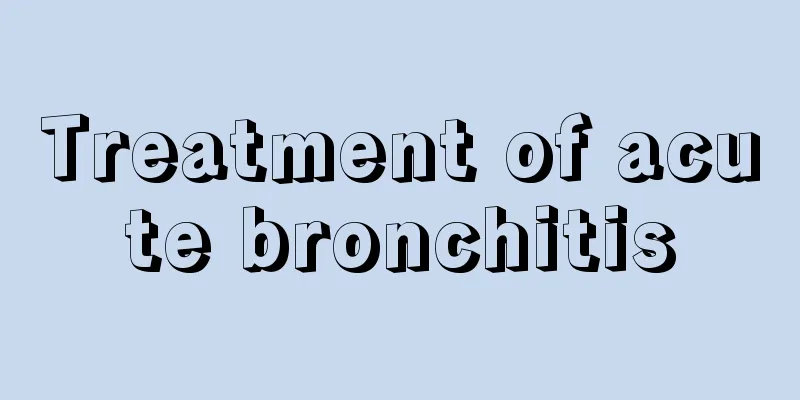Treatment of acute bronchitis

|
Acute bronchitis is an acute inflammation of the bronchial tree mucosa caused by biological or non-biological pathogenic factors. It is not related to chronic bronchitis, so acute bronchitis is the most common disease in life, accompanied by cough, nasal congestion, runny nose, hoarseness and other phenomena. So do you know what are the treatments for acute bronchitis? Let’s take a look at the most commonly used drug treatments. Acute bronchitis cannot be treated the same as chronic bronchitis because their causes are different, but its severity cannot be ignored either, because if it is not treated in time, it will lead to more serious symptoms and also threaten our health. Medication Generally, patients do not need hospitalization. Patients with underlying chronic heart and lung diseases who suffer from severe hypoxia or inadequate ventilation due to bronchitis caused by influenza virus may need to be hospitalized for respiratory support and oxygen therapy. Symptomatic treatment is mainly to relieve cough and expectorate. For patients with severe dry cough, antitussives can be used appropriately. For patients with long-term cough, codeine 10-30 mg, 4 times/day, or benzonatate 100 mg, 3 times/day can be used if necessary. When the sputum is large or sticky, expectorants can be used, such as ambroxol hydrochloride (Mucosolvan) 30 mg, 3 times/day, or bromhexine 16 mg, 3 times/day. For patients with a family history, if wheezing is found during physical examination, inhaled bronchodilators such as salbutamol (Ventolin) or terbutaline can be used, 2 sprays every 4 hours. When accompanied by bronchospasm, aminophylline or β2-receptor agonists can be used. Those with general discomfort and fever as the main symptoms should rest in bed, keep warm, drink plenty of water, and take antipyretics such as aspirin. Antibiotics should not be used routinely for cases where the pathogen is unknown. Blind use of antibiotics can lead to serious consequences such as the development of drug-resistant bacteria and superinfection. However, if the patient has fever, purulent sputum and severe cough, antibiotics are indicated. Patients with acute tracheobronchitis should be treated with antibiotics. Antibiotics against Chlamydia pneumoniae and Mycoplasma pneumoniae can be used, such as erythromycin, 1g per day, taken orally in 4 divided doses. Clarithromycin or azithromycin can also be used. For the elderly and those with underlying cardiopulmonary diseases, oral antibiotics such as macrolides, β-lactams or quinolones can be used. Mycoplasma pneumoniae, Chlamydia trachomatis, and Bordetella pertussis are very sensitive to erythromycin and doxycycline. The above is about the treatment of acute bronchitis. In life, most people face acute bronchitis mainly by controlling it with drugs. Of course, the so-called medication still needs to consult a more professional doctor and take the medication under the guidance of a doctor. Only in this way can the disease be treated safely and effectively. |
<<: Nursing of acute myocardial infarction
>>: Symptoms and treatment of gout in the feet
Recommend
What's the matter with sweating on the top of the head
During TCM treatment, many patients will report t...
Why do socks become hard after washing
I believe many people have experienced this: afte...
What to do if white blisters grow on lips
White blisters on the lips can be said to be a sy...
Is the coldness in the soles of the feet a sign of expelling dampness and cold?
It is said that diseases start from the feet. Man...
What are the essential oils that promote hair growth
If you want to promote hair growth, you can cut g...
Laryngeal cancer needs to be differentiated from the following 4 diseases
The clinical manifestations of laryngeal cancer v...
The efficacy and function of Korean red ginseng
Ginseng grows in the plateau area. There are many...
It is necessary for people to pay attention to the causes of prostate cancer
Prostate cancer is the most common malignant tumo...
What are the symptoms of colon wall thickening
The intestines are located inside us. If there is...
How much does early treatment of lung cancer cost
How much does early treatment of lung cancer cost...
What are the causes of gastric cancer
The incidence of gastric cancer varies in differe...
What are the symptoms of oral disease? Be careful if this happens!
Oral disease is a common clinical disease and als...
Dietary taboos for nasopharyngeal carcinoma
In the diet, you need to eat more fruits and vege...
What are the effects of artificial musk?
Artificial musk is artificially synthesized musk....
How to preserve dried sea cucumber after soaking
I believe everyone must have eaten sea cucumbers ...









